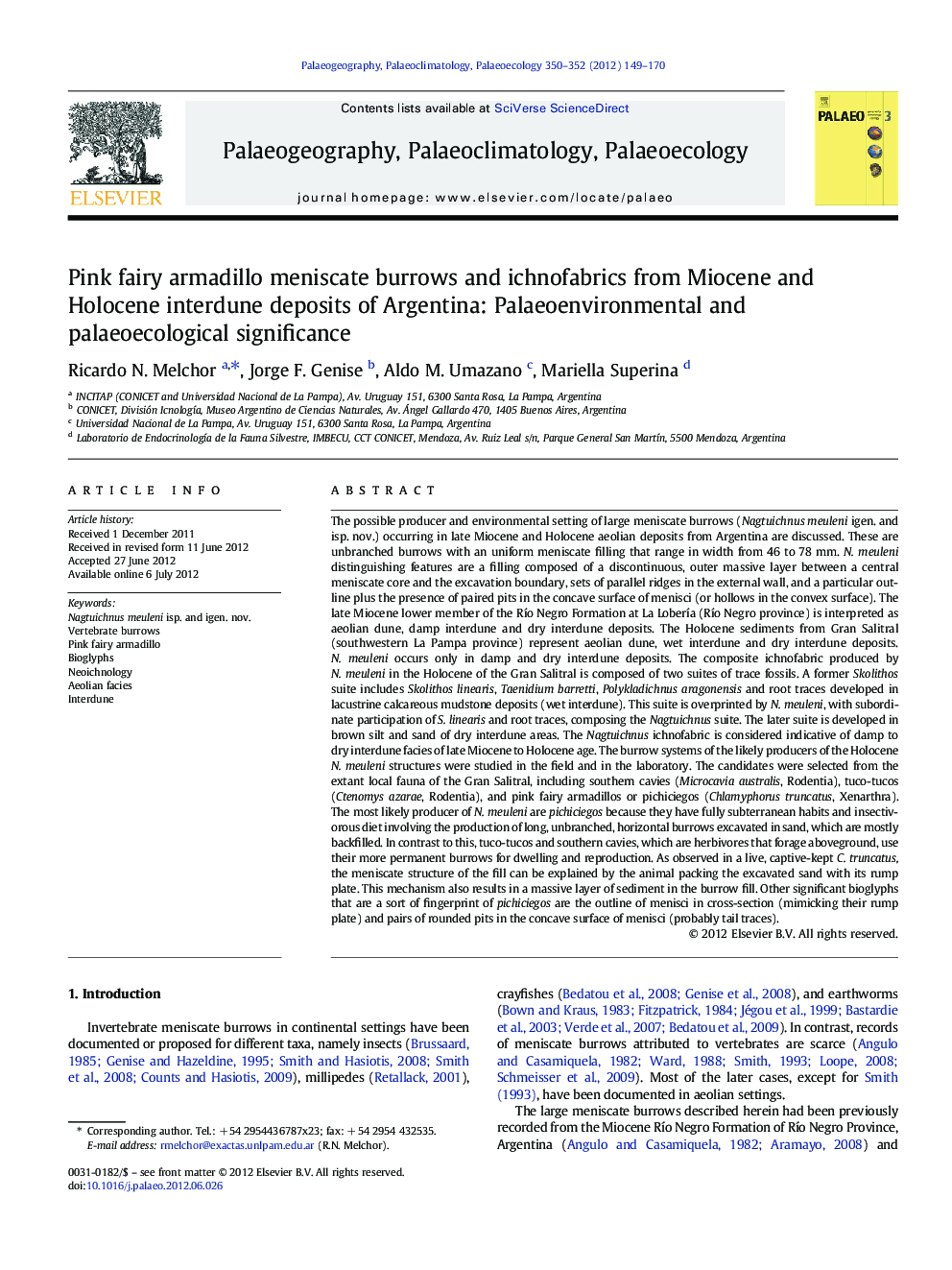| کد مقاله | کد نشریه | سال انتشار | مقاله انگلیسی | نسخه تمام متن |
|---|---|---|---|---|
| 4466826 | 1622225 | 2012 | 22 صفحه PDF | دانلود رایگان |

The possible producer and environmental setting of large meniscate burrows (Nagtuichnus meuleni igen. and isp. nov.) occurring in late Miocene and Holocene aeolian deposits from Argentina are discussed. These are unbranched burrows with an uniform meniscate filling that range in width from 46 to 78 mm. N. meuleni distinguishing features are a filling composed of a discontinuous, outer massive layer between a central meniscate core and the excavation boundary, sets of parallel ridges in the external wall, and a particular outline plus the presence of paired pits in the concave surface of menisci (or hollows in the convex surface). The late Miocene lower member of the Río Negro Formation at La Lobería (Río Negro province) is interpreted as aeolian dune, damp interdune and dry interdune deposits. The Holocene sediments from Gran Salitral (southwestern La Pampa province) represent aeolian dune, wet interdune and dry interdune deposits. N. meuleni occurs only in damp and dry interdune deposits. The composite ichnofabric produced by N. meuleni in the Holocene of the Gran Salitral is composed of two suites of trace fossils. A former Skolithos suite includes Skolithos linearis, Taenidium barretti, Polykladichnus aragonensis and root traces developed in lacustrine calcareous mudstone deposits (wet interdune). This suite is overprinted by N. meuleni, with subordinate participation of S. linearis and root traces, composing the Nagtuichnus suite. The later suite is developed in brown silt and sand of dry interdune areas. The Nagtuichnus ichnofabric is considered indicative of damp to dry interdune facies of late Miocene to Holocene age. The burrow systems of the likely producers of the Holocene N. meuleni structures were studied in the field and in the laboratory. The candidates were selected from the extant local fauna of the Gran Salitral, including southern cavies (Microcavia australis, Rodentia), tuco-tucos (Ctenomys azarae, Rodentia), and pink fairy armadillos or pichiciegos (Chlamyphorus truncatus, Xenarthra). The most likely producer of N. meuleni are pichiciegos because they have fully subterranean habits and insectivorous diet involving the production of long, unbranched, horizontal burrows excavated in sand, which are mostly backfilled. In contrast to this, tuco-tucos and southern cavies, which are herbivores that forage aboveground, use their more permanent burrows for dwelling and reproduction. As observed in a live, captive-kept C. truncatus, the meniscate structure of the fill can be explained by the animal packing the excavated sand with its rump plate. This mechanism also results in a massive layer of sediment in the burrow fill. Other significant bioglyphs that are a sort of fingerprint of pichiciegos are the outline of menisci in cross-section (mimicking their rump plate) and pairs of rounded pits in the concave surface of menisci (probably tail traces).
Figure optionsDownload high-quality image (288 K)Download as PowerPoint slideHighlights
► We studied Miocene and Holocene large meniscate burrows from interdune facies.
► They are recognized under a new ichnogenus and ichnospecies.
► These burrows compose a distinctive ichnofabric.
► We studied the burrows of potential producers from the Holocene locality.
► The burrows share many features with those of the pink fairy armadillo (C. truncatus).
Journal: Palaeogeography, Palaeoclimatology, Palaeoecology - Volumes 350–352, 15 September 2012, Pages 149–170